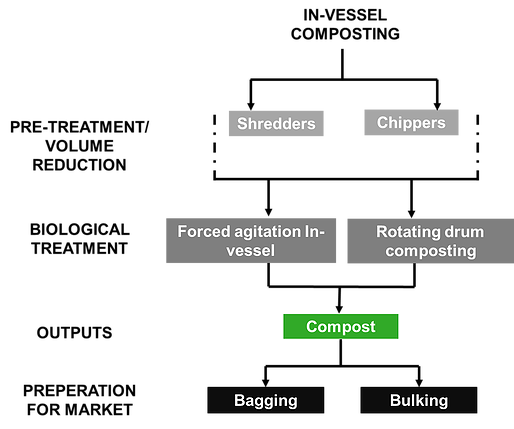In-vessel composting (IVC) is a way of accelerating the composting process within an enclosed environment. Waste will be screened and any oversize items are removed. The waste will then be shredded or chipped to increase the surface area and reduce the average material size. Source segregated of organic wastes will often require a limited amount of treatment prior to composting.
The composting process takes place under controlled conditions in an enclosed environment, either within buildings (bays, beds) or in composting vessels (tunnels, drums, towers).

Configuration
Technology restrictions
- Require several weeks to decompose and stabilise materials
- Requires mechanical agitation techniques
- Moisture content must be controlled through blending with co-substrates or dry feedstock
Main license requirements for IVC
Advantages:
- Completed rapidly, resulting in product stabilisation / sanitation in 3 to 4 days
- Relatively small footprint allows entire process to take place within a controlled environment (inside a building)
- Maintain a rapid decomposition process year-round regardless of external ambient condition
Disadvantages:
- Requires active management to ensure a good mix of materials is processed, in order to develop and maintain good quality compost outputs
- Potential for odour issues
- High use of water
The Latest Plant: Cumbernauld
This plant is designed to compost 20,000 tonnes of class 3 waste per year. The composting plant structure is made up of four adjacent tunnels each of which is 25 metres long, 5.3 metres wide, and 5.3 metres high. These tunnels are constructed in reinforced concrete. Each composting tunnel is filled by front loader through the full width and length, and to the required batch height. Each composting tunnel may be operated independently.
The air to each tunnel is supplied through a series of ducts cast into the floor, with the air emerging into the compost mass through an array of cast-in plastic nozzles. A centrifugal blower is provided for each tunnel. This blower may provide up to 8000 m3/hour of air into the underfloor aeration system. The suction side of the blower is connected to the airspace above the composting material so that the composting blower acts to continuously re-circulate the same mass of air through the compost. Fresh air is provided by a branch pipe on the suction side of the composting blower. Control of the fresh air inlet is effected using a modulating square damper in the branch pipe.
